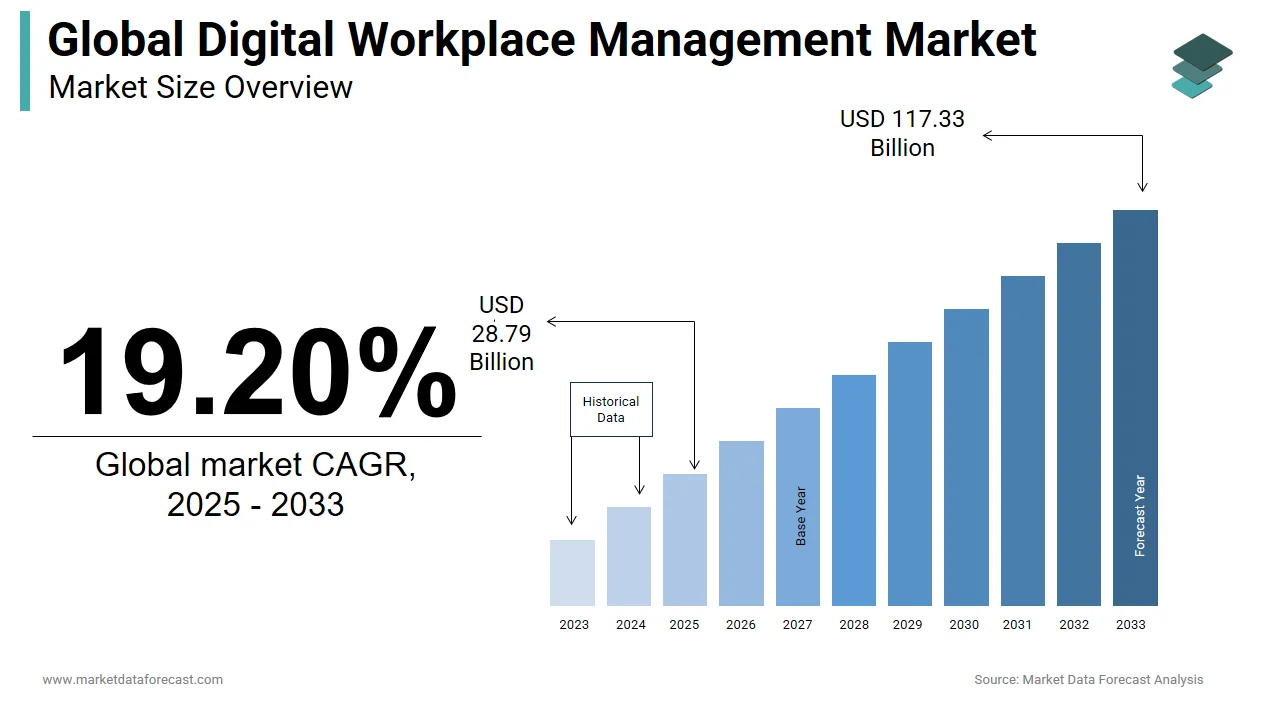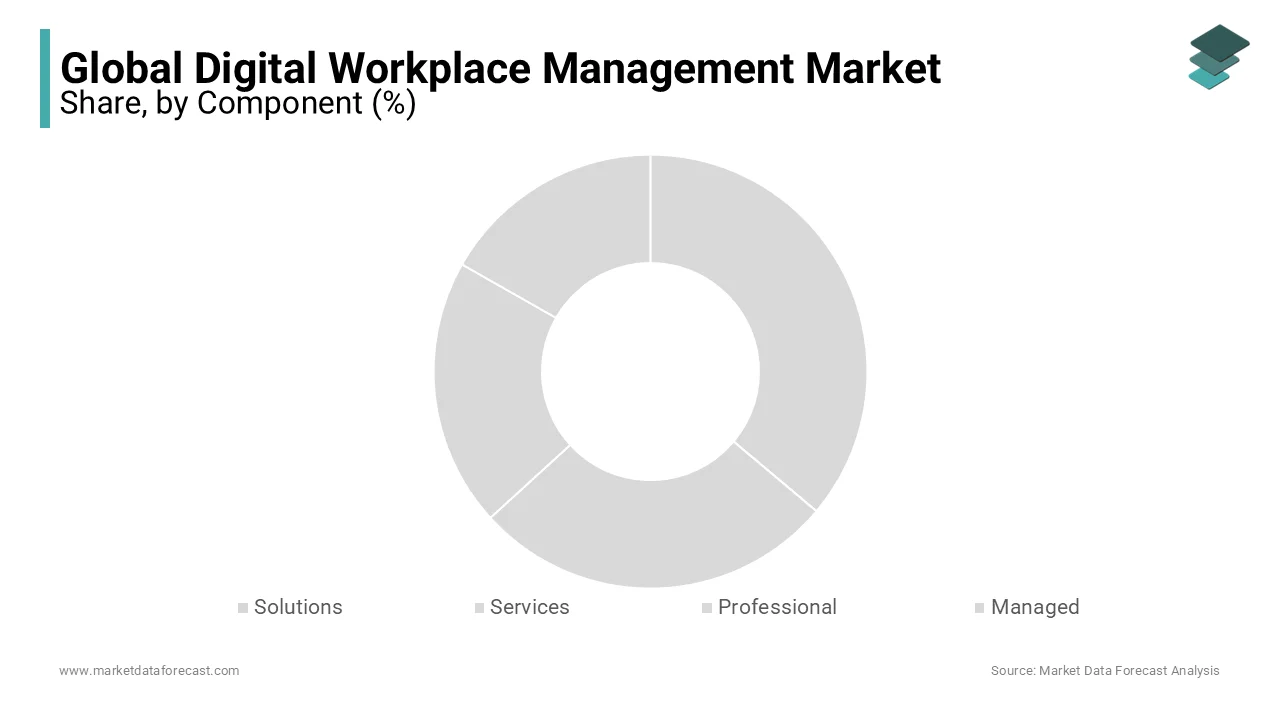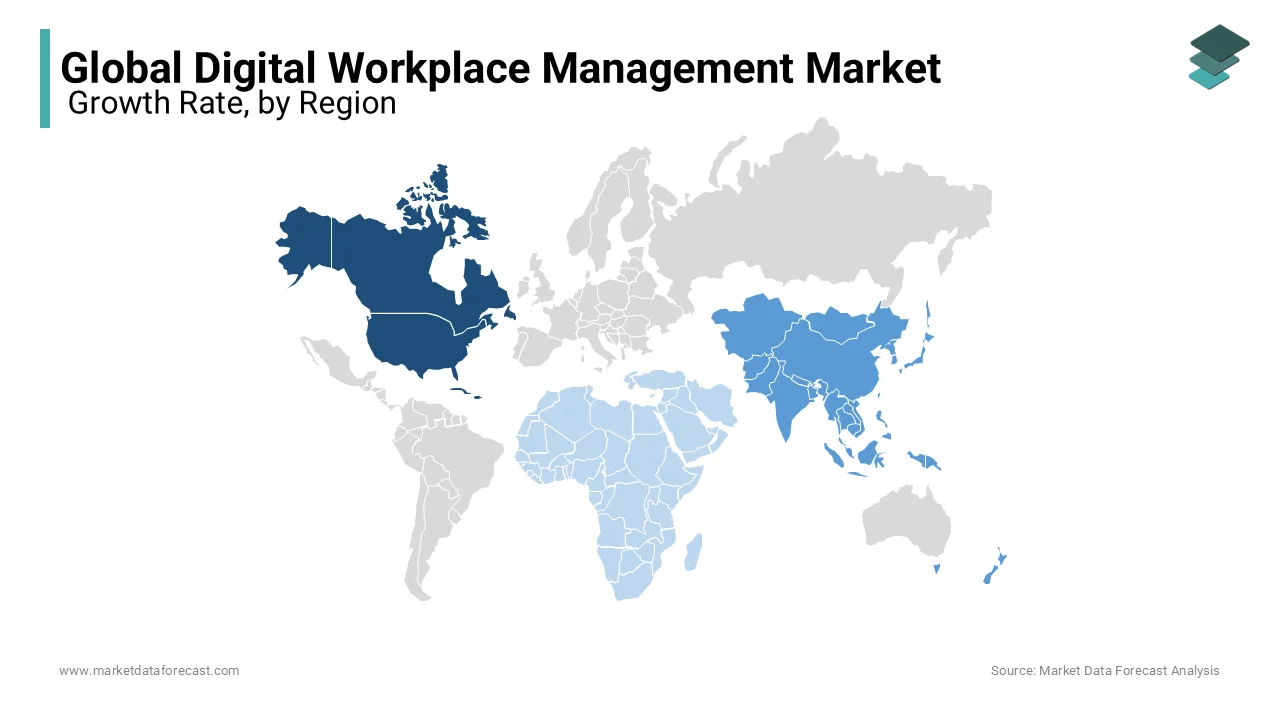Global Digital Workplace Management Market Size, Share, Trends, & Growth Forecast Report – Segmented By Component (Solutions and Services), Organization Size (Small and Medium Sized Enterprises and Large Enterprises), Vertical (BFSI, Telecommunications and ITEs, Media and Entertainment, Retail and Consumer Goods, and Manufacturing) & Region - Industry Forecast From 2024 to 2032
Global Digital Workplace Management Market Size (2024 to 2032)
The global digital workplace managementmarket was worth USD 20.26 bllion in 2023. The global market is predicted to reach USD 24.15 billion in 2024 and USD 98.43 billion by 2032, growing at a CAGR of 19.20% during the forecast period.

Current Scenario of the Market
Modern-day non-stop, linked world from smartphones to machine learning and artificial intelligence via the Internet generated immense amounts of data, for instance, big data. So, the issue is workplace requires quick and dependable methods/approaches to analyse it and turn that into valuable. Moreover, the market also sees the ways that staff or personnel work continue to witness major changes, fuelled by new technologies and the necessity to hold more hybrid functioning. Companies encounter challenges in allowing this contemporary and mobile workplace, comprising those connected with enhancing security, management, and visibility across applications and devices that employees utilise to work efficiently. Modern employees and workplace experiences are digital-first, and companies must adopt new techniques and technologies to handle it.
- According to a report by Lakeside Software, employees acknowledge that technology is the gateway to efficiency and connected workforces. About 60 per cent of employees who participated stated that workplace technology performs a big or extremely huge role in aiding their work life
It is estimated that North America will have the biggest market size among all other areas, and the trend is anticipated to continue until 2025. Regarding digital workplace solutions and services, North America is the most mature market. Because the region is home to many businesses and has extensive technical knowledge, it adopts digital workplace solutions and services to assist businesses with advanced IT infrastructure. As the advantages of implementing cloud technologies become apparent, as well as the need to provide improved quality and safety of software, satisfy compliance requirements, and prevent hazards, businesses are quickly adopting digital workplace alternatives and services.
MARKET DRIVERS
The availability of fresh techniques and instruments enables the improvement of employee management and provides a unified experience.
Advancing intelligent technologies and increasing the implementation of these technologies are driving the general market for digital workplace technologies. There is an increasing need for collaboration and integration in an organization of technology, instruments, apps, culture, and individuals. Improved resource utilization leads to improved safety and delivery of applications.
The first phase of the research process is extensive secondary research and identifying the related intelligence. Secondary data is compiled from various sources. Extensive secondary research helps generate hypotheses and identify critical areas of interest that are investigated through primary research. This entails conducting hundreds of primary interviews with industry participants and commentators to validate the data points obtained from secondary research and to fill the data gaps. A primary interview provides first-hand information on the market size, growth trends, competitive landscape, future outlook, etc. It also helps in deciding the scope and deliverables of the study in terms of the market requirements. Primary research involves e-mail interactions, M telephonic interviews, and face-to-face interviews for to each market, category, segment, and sub-segment across geographies.
Digital Workplace Management is radically altering how employees operate, and the guidelines for employee engagement, cooperation, and productivity are being rewritten. Digital Workplace Management, made up of all the techniques that individuals use to get the job done in today's contemporary job setting, enables the aggregation of these instruments into a common user experience that has created a whole marketplace of alternatives, many but not all constructed on top of the Microsoft technology stack. The digital workplace comprises intelligible, usable, and productive instruments, platforms, systems, and environments for job delivery. A digital workplace makes it possible to work more efficiently, increasing employee engagement and productivity. Furthermore, the solution provides a straightforward and intuitive user interface for the organization to operate across different departments.
MARKET RESTRAINTS
Technology is the primary element of the digital workplace, and business planning that is being converted into digital is also needed. Initial investment is high when the workplace is digitized. It needs upfront or advanced investment and consistent costs, involving updates, management, training, and setup.
Apart from this, the market players are also struggling because of the necessity of dependable and robust internet connectivity at all working hours. In its absence, work leads to a gridlock.
Susceptible to cyber and other innovative risks and dangers. In contrast to conventional models, where resources and assets are more secured from outside forces or interferences, valuable information can become an objective for corporate espionage, hackers, and other malicious actors.
MARKET OPPORTUNITIES
The future of digital workplace management is promising with smart tools, enhanced security, cloud-based solutions, modern technologies, and dynamic signage.
Blockchain for the virtual workspace presents revolutionary power to companies, enabling businesses to attain enhancements in both capability and productivity, which ultimately accelerates the market growth rate. Moreover, this technology removes the requirement for intermediary third parties and also helps in building confidence by not allowing to alter the data added to the blockchain. Besides this, it basically strengthens the security, transparency, ownership, and, as a result, the value of the records and procedures they manage. Blockchain technology provides endless applications from smart agreements, distributed autonomous enterprises, supply chain management, digital identity, decentralized finance, virtual autonomous agents, etc.
Artificial intelligence is still in its initial stage of application in workspace management and is bound to transform the market in the coming years. Companies are switching to automation to not only keep up but also to gain a competitive edge in the new economy by removing manual work and substituting it with more productive processes propelled by artificial intelligence. Also, they’re searching for ways or techniques to use AI better to enhance how they apply personnel data.
- As per research, about 60 per cent of large organizations and mid-size companies will be utilising cloud-based HCM suites for talent management and administration.
MARKET CHALLENGES
Enterprise security concerns derail the growth trajectory of the digital workplace management market. Protecting applications and sensitive data in a distributed, connected, and cloud-based virtual workspace is a key challenge. Staff or professionals accessing confidential information from several devices and locations augments risk vectors, resulting in exposing weaknesses, compromising systems, and, in the end, leading to cyberattacks that cause data breaches.
The lack of sufficient measures to secure remote and mobile access is another critical issue in front of the market players. This presents a huge amount of problems for companies in the modern-day virtual environment. The danger of cyber threats aimed at remote employees is intensified because of the expansion of cloud-based applications and endpoints, along with the decentralized work environments. One of the main issues is providing secure access to corporate resources from different locations and systems and, at the same time, ensuring data privacy and integrity. Furthermore, remote employees may lack cognizance of best practices used in cybersecurity, leading to accidental security breaches or information leaks and vulnerabilities. In addition, the use of personal systems and unprotected networks further aggravates security risks, making it tough for companies to implement uniform security controls and policies.
REPORT COVERAGE
|
REPORT METRIC |
DETAILS |
|
Market Size Available |
2023 to 2032 |
|
Base Year |
2023 |
|
Forecast Period |
2024 to 2032 |
|
CAGR |
19.2% |
|
Segments Covered |
By Component, Organization Size, Vertical, and Region. |
|
Various Analyses Covered |
Global, Regional & Country Level Analysis, Segment-Level Analysis, DROC, PESTLE Analysis, Porter’s Five Forces Analysis, Competitive Landscape, Analyst Overview on Investment Opportunities |
|
Regions Covered |
North America, Europe, APAC, Latin America, Middle East & Africa |
|
Market Leaders Profiled |
IBM, Atos, Wipro, DXC Technology, NTT Data, Citrix, Unisys, Capgemini, Cognizant, Accenture, TCS, CompuCom, HCL, Stefanini, Computacenter, Getronics and Others. |
SEGMENTAL ANALYSIS
Global Digital Workplace Management Market Analysis By Component

The professional segment is expected to lead the digital workplace management market and is likely to expand during the forecast period.
Professional services assist in consulting, integrating, and supporting organizations across different sectors to efficiently address threats, ensuring visibility and safety across all company functions. Moreover, digital office spaces are becoming increasingly popular, attracting the attention of forward-looking experts or specialists like entrepreneurs, freelancers, etc. These unique workplaces are transforming the methods of working, facilitating employees with the adaptability and freedom to succeed in a dynamic environment.
- As per Statista, by 2025, approximately 88 per cent of professional services organizations around the world are believed to embrace cloud computing technology, with about 86 per cent likely to accept big data analytics and around 76 per cent expected to deploy machine learning and AI technology.
Global Digital Workplace Management Market Analysis By Organization Size
The large enterprise segment gained the maximum share of the digital workplace management market and is likely to maintain its position throughout the estimation period.
- According to research, more than 90 per cent of companies are engaged in some sort of digital program in 2024. Also, 89 per cent of all organizations have already implemented a business strategy of digital-first or are in the planning stage.
In the large enterprise segment, the adoption of digital workplace solutions and services is greater, and the trend is anticipated to proceed over the forecast period. Large companies invest substantially in tactical marketing techniques to maintain their positions in highly competitive markets.
Global Digital Workplace Management Market Analysis By Vertical
The BFSI Segment attained the highest growth rate in the digital workplace management market and prospects are to have potential expansion during the forecast period. In today’s quickly-moving digital age, while online banking apps and channels provide incomparable comfort, there’s a surging recognition that a just digital presence isn’t sufficient.
Companies are quickly adopting digital workplace solutions and services by leveraging other sophisticated techniques, such as facial recognition software, mobile platforms, and radio frequency identification.
REGIONAL ANALYSIS

North America is leading in adoption due to solid technology infrastructure and high digital literacy.
Europe follows closely, propelled by a proactive attitude to digital transformation.
Asia-Pacific has considerable development potential, driven by growing economies adopting digital solutions.
The Middle East and Africa are undergoing steady growth, encouraged by increased awareness and investment in digital activities.
Latin America's growth is moderate, reflecting a combination of technology advancements and economic factors. Overall, market dynamics across regions point to a global digital workplace management adoption trend, with regional differences influencing the global digital workplace management market.
KEY MARKET PARTICIPANTS IN THE GLOBAL DIGITAL WORKPLACE MANAGEMENT MARKET
The major companies operating in the global digital workplace management market include IBM, Atos, Wipro, DXC Technology, NTT Data, Citrix, Unisys, Capgemini, Cognizant, Accenture, TCS, CompuCom, HCL, Stefanini, Computacenter, and Getronics.
RECENT HAPPENINGS IN THE GLOBAL DIGITAL WORKPLACE MANAGEMENT MARKET
-
In May 2018, Citrix unveiled fresh technologies that promote the transition to people-centered computing. This allows organizations to offer a superior work experience that unifies everything a worker wants in one location while meeting the organization's most stringent compliance and safety needs.
-
In May 2018, DXC Technology announced on Amazon Web Services (AWS) DXC Platform as a Service (PaaS) for SAP solutions. The fresh offering is an expansion of DXC PaaS for SAP solutions, providing customers with a cost-effective transition choice and transforming their SAP solutions into an on-demand, automated cloud platform.
DETAILED SEGMENTATION OF THE GLOBAL DIGITAL WORKPLACE MANAGEMENT MARKET INCLUDED IN THIS REPORT
This research report on the global digital workplace management market has been segmented and sub-segmented based on the component, organization size, vertical, and region.
By Component
-
Solutions
-
Services
-
Professional
-
Managed
By Organization Size
-
Small and Medium-Sized Enterprises
-
Large Enterprises
By Vertical
-
BFSI
-
Telecommunications and ITEs
-
Media and Entertainment
-
Retail and Consumer Goods
-
Manufacturing
By Region
-
North America
-
The United States
-
Canada
-
Rest of North America
-
-
Europe
-
The United Kingdom
-
Spain
-
Germany
-
Italy
-
France
-
Rest of Europe
-
-
The Asia Pacific
-
India
-
Japan
-
China
-
Australia
-
Singapore
-
Malaysia
-
South Korea
-
New Zealand
-
Southeast Asia
-
-
Latin America
-
Brazil
-
Argentina
-
Mexico
-
Rest of LATAM
-
-
The Middle East and Africa
-
Saudi Arabia
-
UAE
-
Lebanon
-
Jordan
-
Cyprus
-
Frequently Asked Questions
Which industry vertical is witnessing the fastest growth in the Digital Workplace Management Market globally?
The BFSI (Banking, Financial Services, and Insurance) sector is experiencing the fastest growth, driven by the need for secure and efficient digital collaboration tools.
How is the Digital Workplace Management Market responding to the rising demand for hybrid work models?
The market is evolving to provide solutions that support seamless collaboration between in-office and remote teams, emphasizing flexibility and adaptability.
What role does cybersecurity play in the Digital Workplace Management Market?
Cybersecurity is a critical aspect, and the market is witnessing a surge in solutions focusing on secure access, data protection, and threat detection to address the increasing risk of cyberattacks.
How does the Digital Workplace Management Market address the needs of small and medium-sized enterprises (SMEs) on a global scale?
The market offers scalable and cost-effective solutions tailored for SMEs, enabling them to adopt digital workplace technologies without a significant financial burden.
Related Reports
Access the study in MULTIPLE FORMATS
Purchase options starting from $ 2500
Didn’t find what you’re looking for?
TALK TO OUR ANALYST TEAM
Need something within your budget?
NO WORRIES! WE GOT YOU COVERED!
Call us on: +1 888 702 9696 (U.S Toll Free)
Write to us: [email protected]